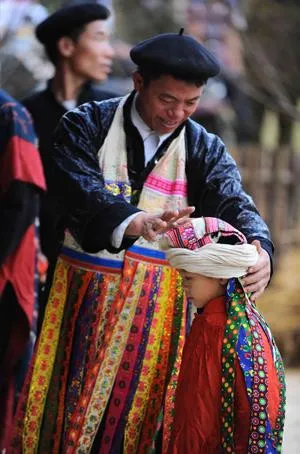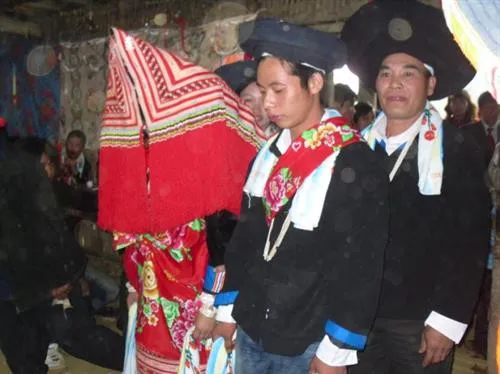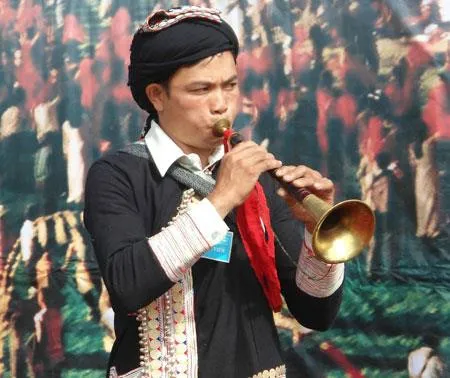The Dao people, one of Vietnam’s most culturally rich ethnic minorities, are renowned for their unique rituals and festivals. These events reflect their vibrant spiritual life and deep connection to nature and community. From the graceful dances of the Tet Nhay festival to the solemn rites of the Cap Sac ceremony, Dao festival culture is not just a time for fun and entertainment. It’s a vital opportunity to preserve and promote precious traditional cultural values, strengthen community bonds, and educate younger generations about their ethnic roots. Join “Du lịch khắp thế gian” as we explore the unique aspects of Dao festival culture, gaining deeper insights into Vietnam’s diverse and beautiful cultural identity.
Tet Nhay – Springtime Spiritual Dance of the Dao People
Tet Nhay, also known as “Dance Festival,” is one of the most important and distinctive festivals of the Dao people. It is usually held during the Lunar New Year (Tet Nguyen Dan) and is deeply rooted in spiritual and folk art values. More than just entertainment, Tet Nhay is a time for the Dao community to express reverence for their ancestors, pray for a peaceful new year, bountiful harvests, and a prosperous, happy life.

Tet Nhay typically takes place in the twelfth lunar month, about half a month before Tet Nguyen Dan, and lasts for several days. To prepare for the festival, young men in the village practice traditional dances and movements, and prepare wooden swords and knives for use in rituals. In the joyful atmosphere of Tet, villagers gather at the village chief’s house or a family chosen on a rotational basis to conduct Tet Nhay together.
The highlight of Tet Nhay is the unique dances and movements performed continuously to the vibrant sounds of bells and drums. Festival participants, from young people to the elderly, immerse themselves in powerful, graceful dances that express martial spirit and community cohesion. These dances are not only artistic but also contain deep spiritual meanings, mimicking production activities, daily life, and expressing aspirations for a better life.
Tet Nhay is not just a festival for individual families but for the entire village. Everyone participates together, sharing joy and wishing each other good things in the new year. The festival is a harmonious combination of music, dance, language, and costumes, creating a colorful and unique cultural picture that clearly reflects the distinct cultural identity of the Dao people.
Le Cap Sac – Sacred Coming-of-Age Ceremony
Le Cap Sac, the Coming-of-Age Ceremony, is one of the most important rituals in a Dao man’s life. It marks his maturity and recognition as an official member of the community. This ceremony is imbued with religious beliefs, reflecting deep-rooted traditional cultural values and playing a crucial role in maintaining and preserving the cultural identity of the Dao people.

Le Cap Sac is usually held when a Dao son reaches adulthood, typically from the age of 12 onwards. To prepare for the ceremony, the family must prepare offerings, invite a respected shaman, and inform relatives and villagers. Le Cap Sac often lasts for several days, with many complex rituals that demonstrate the solemnity and sacredness of the ceremony.
During Le Cap Sac, the person undergoing the ceremony must endure various trials and rituals, demonstrating courage, perseverance, and sincerity. The rituals include presenting oneself to ancestors, a purification bath, offerings to deities, receiving a pháp danh (spiritual name), and receiving the sắc phong (mandate). After completing these rituals, the Dao son is officially recognized as an adult man with full rights and responsibilities in the community.
Le Cap Sac is not just a personal ritual but also an important event for the entire lineage and community. This ceremony helps educate young Dao people about responsibility, national pride, and community solidarity. At the same time, Le Cap Sac is also an opportunity to preserve and promote traditional cultural values, such as music, dance, costumes, and ancient worship rituals.
Traditional Tet – Immersing in a Colorful Cultural Space
Traditional Tet of the Dao people, similar to Tet Nguyen Dan of the Kinh people, is the biggest festival of the year, holding special significance in the community’s spiritual and cultural life. This is a time for everyone to gather, reunite, celebrate the new year together, and wish for good things to come.
The time of Traditional Tet for the Dao people usually coincides with Tet Nguyen Dan of the Vietnamese people, or sometimes about half a month earlier, and lasts for a similar period. During the Tet days, the village atmosphere becomes bustling and lively with Tet preparations, entertainment activities, and traditional rituals.
During Tet days, Dao people often prepare ancestral offerings with typical traditional dishes such as bánh chưng (square sticky rice cake), thịt đông (jellied meat), boiled chicken, ngũ sắc xôi (five-colored sticky rice), and other local specialties. Entertainment activities during Tet are diverse, including folk games such as swings, throwing còn (cloth ball), tug-of-war, Pao Dung singing, khen (panpipe) dancing, and other cultural and artistic activities.

A special feature of Traditional Tet for the Dao people is the harmonious combination of traditional and modern cultural elements. In addition to maintaining traditional rituals and customs, the Dao people also embrace new cultural aspects, creating a diverse, rich, and distinctively ethnic Tet cultural space. Traditional Tet is not just a time for fun and entertainment but also an opportunity to strengthen community bonds and preserve and promote the precious traditional cultural values of the Dao people.
Other Festivals – Discovering a Rich Spiritual World
Besides Tet Nhay, Le Cap Sac, and Traditional Tet, the Dao people have many other festivals and rituals that reflect their rich and diverse spiritual world. These festivals are often associated with agricultural production activities, ancestor worship, deities, and important events in community life.
Among the other festivals and rituals of the Dao people, we can mention:
- Nương Worshiping Ceremony: Held at the beginning of the year, before starting a new crop season, to pray for favorable weather, bountiful harvests, and a prosperous life.
- New Rice Ceremony: Takes place after the harvest season, to thank the gods for granting a successful harvest and pray for an even better harvest in the following year.
- Rice Seed Worshiping Ceremony: Held before sowing a new crop, to pray for good seed germination, healthy plant growth, and high yields.
- Livestock Soul Worshiping Ceremony: To pray for healthy livestock, prosperity, and freedom from disease.
These festivals and rituals are not only spiritually significant but also play an important role in maintaining and preserving the traditional customs and practices of the Dao people. Through festivals, the Dao community expresses solidarity, shares, and helps each other, while also educating younger generations about the good cultural values of their ethnicity.
Preserving and Promoting the Value of Dao Festival Culture
Dao festival culture is an indispensable part of the diverse and rich cultural tapestry of Vietnam. These unique festivals, deeply imbued with traditional cultural identity, are not only the pride of the Dao people but also a precious cultural asset of the entire nation.
In the context of rapidly developing modern society, preserving and promoting the value of Dao festival culture is extremely important. It requires the joint efforts of the community, authorities at all levels, and cultural organizations to support and encourage the Dao people to maintain and develop traditional festivals, while also introducing and promoting these unique cultural values to domestic and international tourists.

Preserving Dao festival culture is not only about preserving traditional values but also about contributing to enriching the spiritual and cultural life of society, promoting cultural tourism development, and strengthening understanding and cultural exchange between ethnic groups. Let us cherish and protect these precious cultural heritages together, so that Dao festival culture may forever endure and shine in the flow of Vietnamese culture.
Reference Source: baocaobang.gov.vn